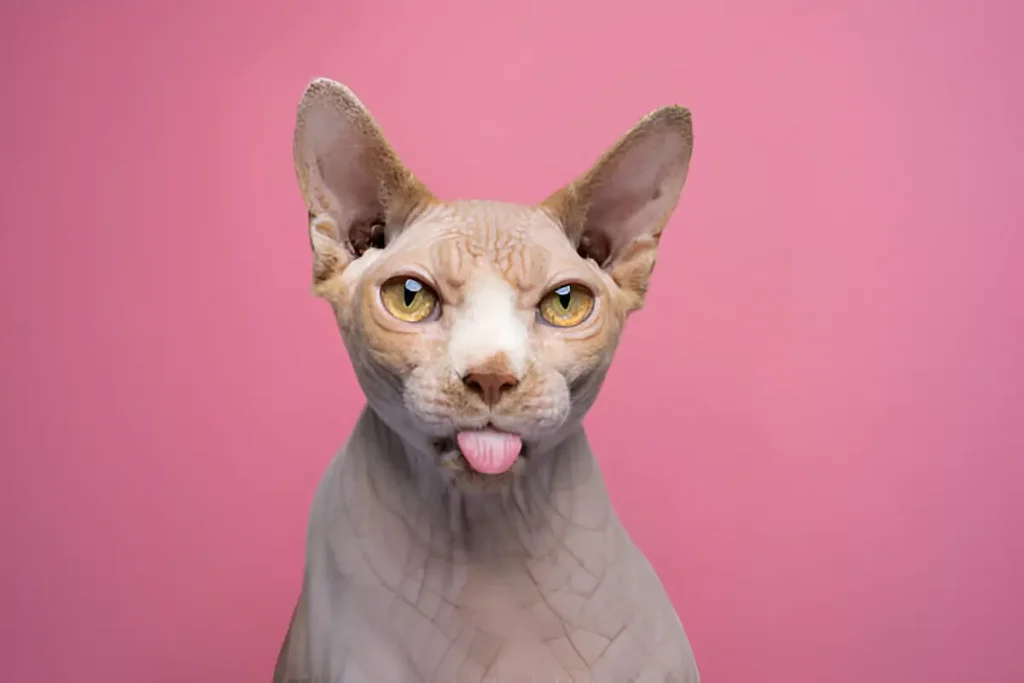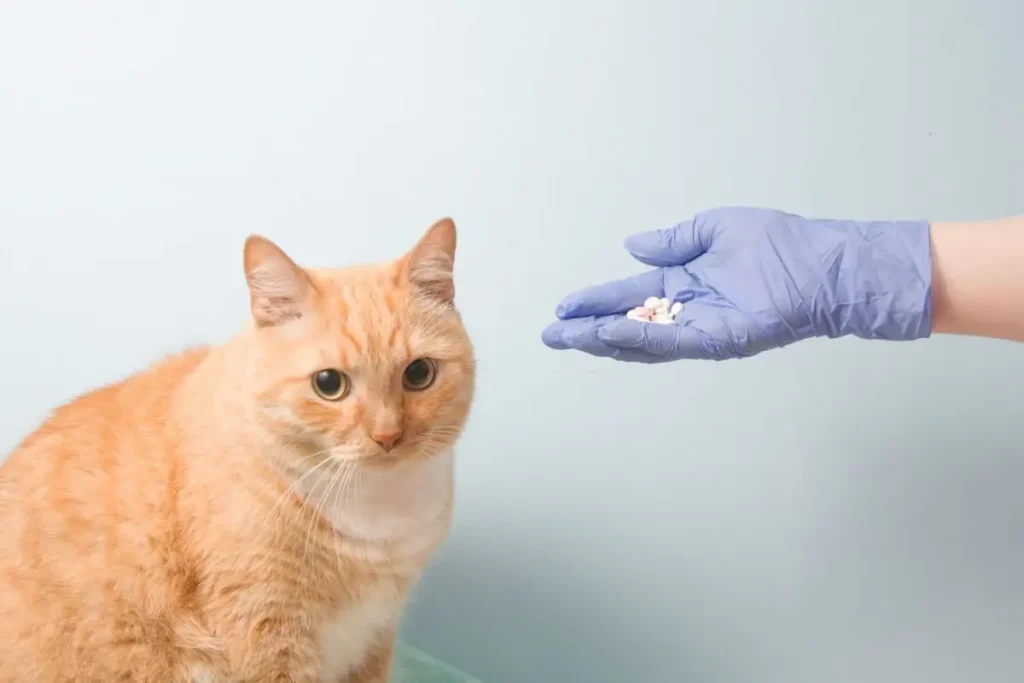Hairless cats are a real treat for the eyes. There are several recognized breeds, from the Sphinx to Bambino, and each is special in its own way. Some hairless cats have very fine peach fuzz, while others are really smooth to the touch. Keep in mind, however, that these cats tend to be more expensive because they are rarer than your average house cats.
Are hairless cat breeds hypoallergenic?
Many believe that because a cat has no hair, it is automatically hypoallergenic, but this is not true.
It is actually not the fur of a cat that humans are allergic to, but the proteins found in the skin (scales) and saliva. However, people with sensitivities are less likely to have a reaction from a bald cat because it doesn’t shed as much, and therefore its fur doesn’t stick to surfaces in the house.
Caring for hairless cat breeds
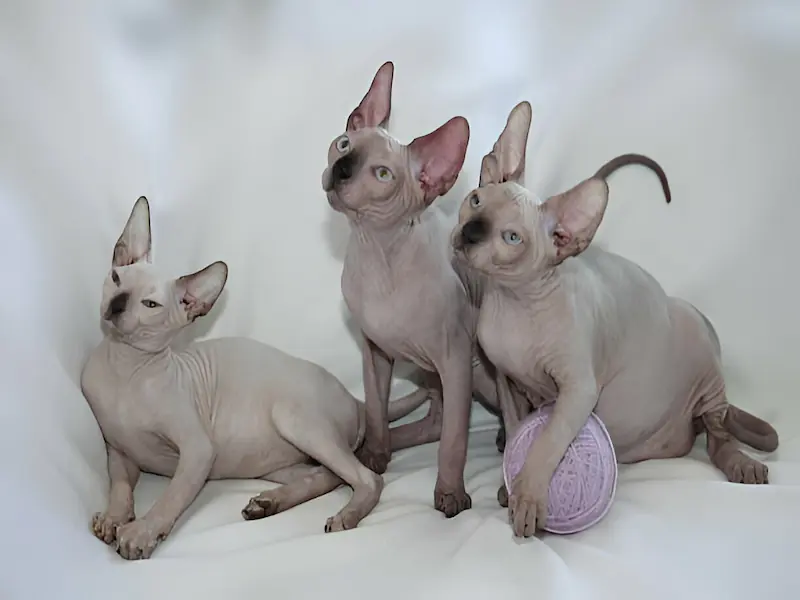
If you choose a hairless cat breed, you should be aware that it needs special care. If it’s colder, you’ll probably need coats or a sweater to stay warm, and it’s important to keep your home well heated as well. When summer arrives, you may want to invest in a cat-friendly sunscreen. If you want to let your cat outside, avoid hot days and lunchtimes when the sun is at its peak. However, because hairless cats are very sensitive to the elements, it is often a good idea to keep them as housecats.
Additionally, you will need to bathe your bald cat regularly – once a week should be enough – as he has no hair that can absorb oil from his skin. If you don’t prevent oil buildup on your cat’s skin, your cat will likely feel sticky and uncomfortable and may have skin problems. Also, some hairless cats may not have eyelashes, so you need to be careful to gently clean the eye area with a damp cloth from time to time.
Related: 7 of the best hairless cat breeds around the world
Characteristics of the breed
Hairless breeds are the result of genetic mutations that have lost their protective coat. These cats need special care. They often have trouble staying warm, so they need sweaters and cold-weather gear. And if your cat lies on the windowsill for a long time, his skin needs sun protection. Additionally, some hairless kittens require regular bathing to prevent oil buildup on the skin. Hairless cats also tend to be more active and have a higher metabolism. They often need high-quality feed to meet their energy needs.
Here are 12 breeds to consider if you are interested in adopting a Hairless cat.
hairless cat breeds list:
1- Ukrainian Levkoy
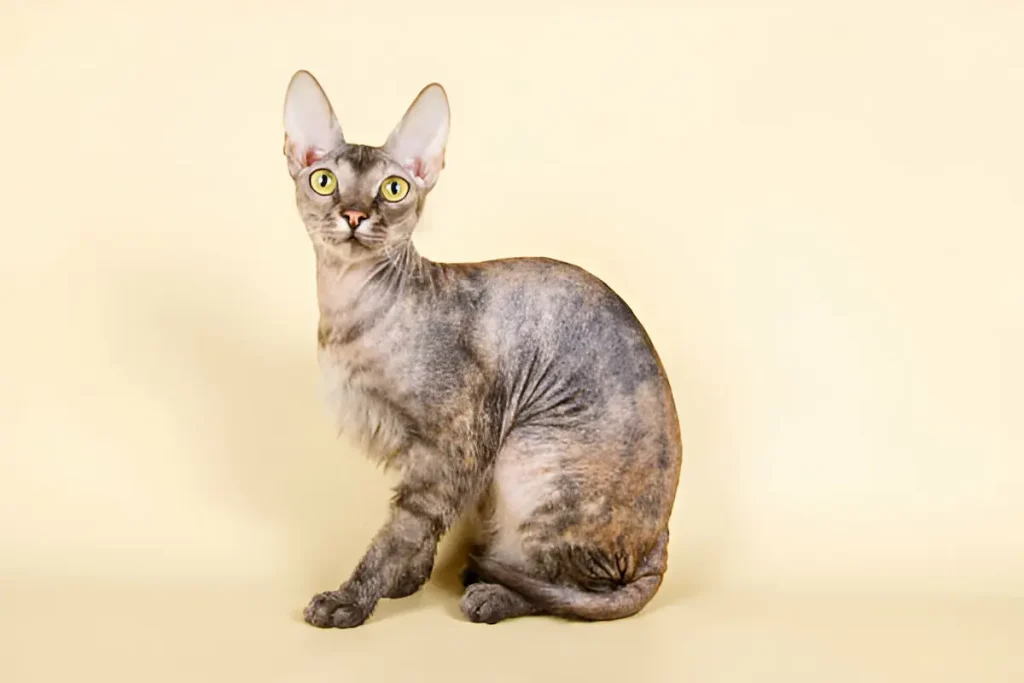
With its hairless body and ears folded inward, the Ukrainian Levkoy has a unique appearance. These cats were the result of a cross between the Donsk and Scottish Fold breeds. Many also get along well with other pets.
Interesting Fact: Ukrainian Levkoy cats are incredibly intelligent and are excellent at finding things. So you have to be careful where you hide the treats!
HEIGHT: 7 to 10 inches
WEIGHT: 8 to 12 pounds
2- Minskin
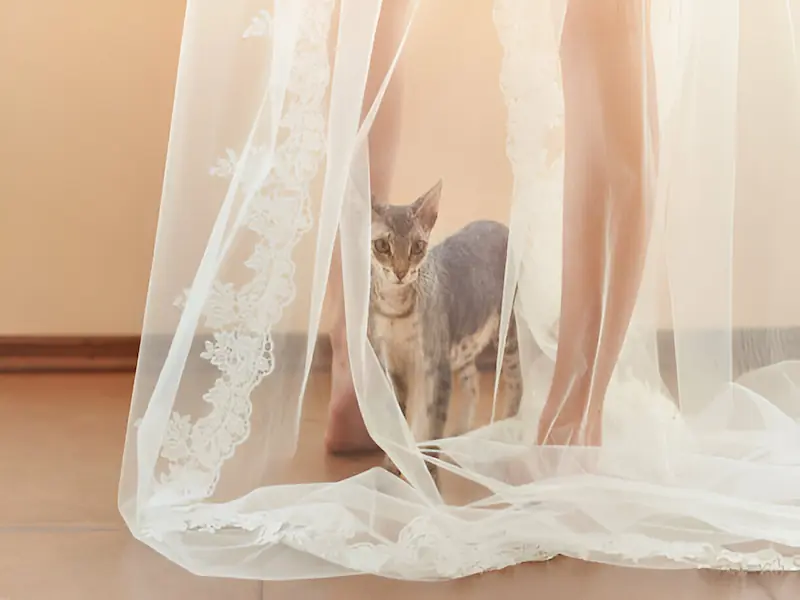
The Minskin is a short-legged hairless cat that emerged from crossbreeding between a Munchin and a sphinx. These cats often have thin, thin fur on their bodies, especially on the “tips” (nose, ears, paws, and tail). Their bellies are almost always hairless.
HEIGHT: 7 to 8 inches
WEIGHT: 4 to 6 pounds
3- Elf
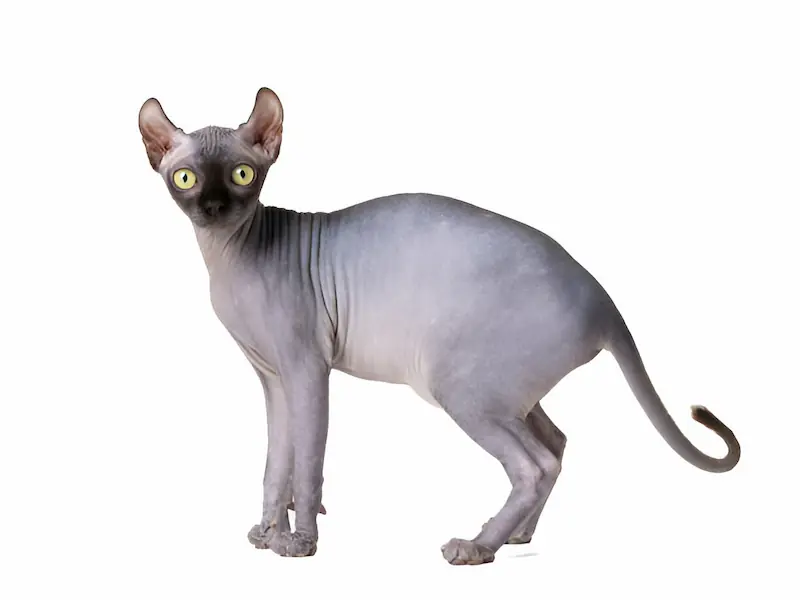
By crossing a sphinx and an American curl you get the friendly and playful Elf cat, a larger version of the Dwarf. The soft skin of these cats is typically soft to the touch, similar to peach fuzz. Some have light tufts of hair on their ears, noses, paws, or tails.
HEIGHT: 8 to 10 inches
WEIGHT: 10 to 15 pounds
4- Sphinx
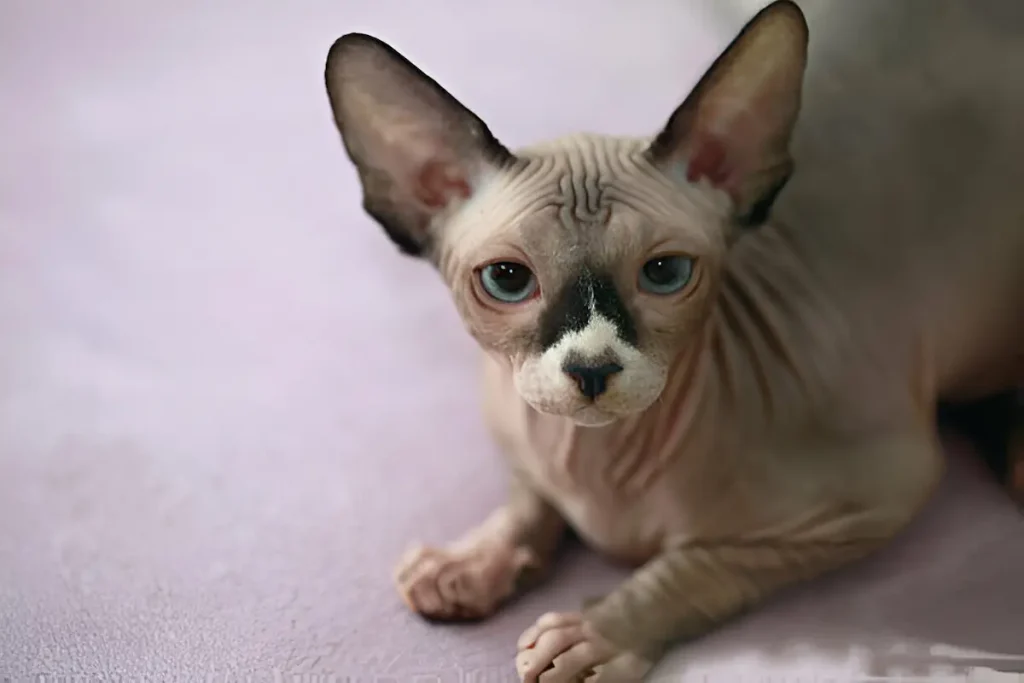
The most famous breed of hairless cat is the Sphinx, which originated in Canada in 1960. As a result of a naturally occurring recessive genetic mutation, the Sphinx was developed by breeding with short-haired cats to create a healthy and healthy gene pool. ample. Some Sphinx cats have soft fur or tufts of fur, especially on the face, legs, and tail.
HEIGHT: 8 to 10 inches
WEIGHT: 10 to 12 pounds
5- Dwelf
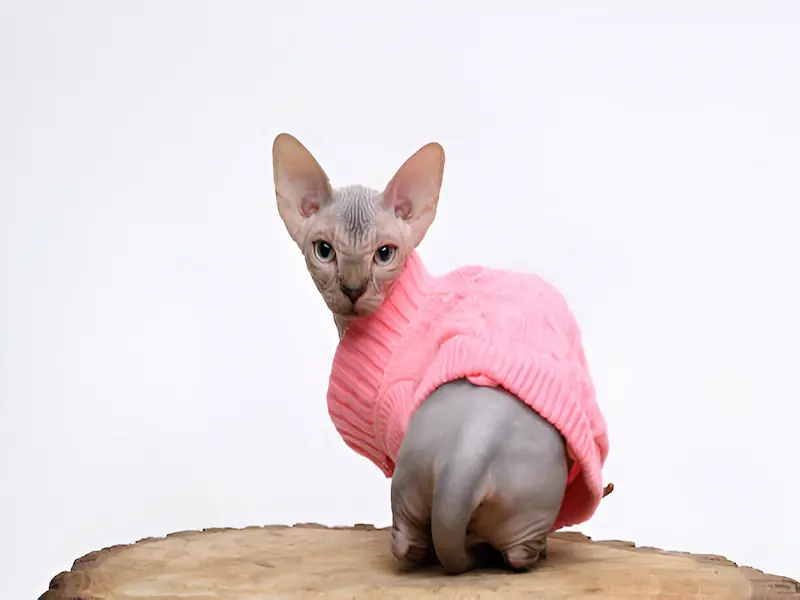
The Dwarf comes from crosses between the Munchkin, American Curl, and Sphinx cat breeds.1 Several mutations have led to the hairless, compact, and elfin appearance of this breed, contributing to health problems, including skeletal problems. However, these cats tend to be very involved with their families.
HEIGHT: 6 to 7 inches
WEIGHT: 4 to 9 pounds
6- Bambino
The Bambino is a small Hairless cat, as its name suggests: “bambino” or “baby” in Italian. This Dwarf cat is a cross between the Sphinx and the Munchkin. Some may have hair, mainly on the face, ears, legs, and tail, while others are completely hairless.
This hairless cat is incredibly playful and super fast despite his small legs!
HEIGHT: 7 to 8 inches
WEIGHT: 5 to 9 pounds
7- Lykoi
The Lykoi, also called Werewolf Cat, is not always hairless. Some Lykoi cats are completely covered in the breed’s characteristic blackish-grey coat, while others are predominantly hairless. Most of these cats have no hair on their faces, backs of their ears, legs, or feet.
HEIGHT: 8 to 10 inches
WEIGHT: 4 to 7 pounds
8- Donskoy
The Donskoy is also known as the Russian Glabra Sphinx, Don Glabra, or Don and is different from the Sphinx. The Sphinx’s lack of hair is due to a recessive genetic mutation. Meanwhile, the Donskoy owe their Glabra to a dominant gene. Interestingly, some Donskoy cats partially develop a winter coat when the weather is cooler and lose it as temperatures get warmer.
HEIGHT: 10 to 12 inches
WEIGHT: 7 to 15 pounds
9- Sphinx hybrids
Breeders continue to use the hairless mutation in Sphinx cats to produce new hybrids. The Sphinx BOB, for example, is a cross between a sphinx and an American Bobtail and was born in 2015. It looks almost the same as the Sphinx, but is tailless or has a short, wavy tail. Although most hybrids are not officially recognized breeds, they expand the spectrum of hairless cats.
HEIGHT: 8 to 10 inches
WEIGHT: 10 to 12 pounds
10- Peterbald
The Peterbald is an elegant cat with distinctive features and long limbs. They were born from a cross between Donsk and Oriental Shorthair. Not all Peterbalds are born hairless. Some kittens have fine, soft fur that they shed or retain throughout their lives. Occasionally, a Peterbald is born as a typical cat with full fur.
HEIGHT: 8 to 10 inches
WEIGHT: 6 to 10 pounds
11- Kohana
Unlike many of the hairless cat breeds on this list, Kohana cats originate from Hawaii and are a mutation of the Sphynx cat. Kohana cats are docile and endearing, making them a popular choice for households with young children and other animals.
12- Oriental Shorthair
Oriental Shorthair cats are known for their striking coat patterns and colors. Though most are not totally hairless, some members of this breed may carry a hairless gene—resulting in a nearly hairless coat.
This cat is long and muscular: a long slender body, long tail, and long neck, and is known to move gracefully around the home. They are highly intelligent and affectionate but require attentive cat owners.
FAQs
Are there different types of hairless cats?
Dr. Cauthen tells Parade Pets: “There are several types of hairless cats, with the Sphinx and the Donskoi being the two most common.” He continues: “Other varieties include Crossing a Sphinx with a Munchkin, which resulted in a Child, or The crossing of a Donskoe with a Scottish fold, from which the Ukrainian Levkoi resulted.“
Are Sphynx cats Egyptian?
No, the Sphinx Cat is a very young breed that was developed around the same time in Wisconsin, USA, and Ontario, Canada. They originated from spontaneous mutations in the 1960s, but have only enjoyed widespread popularity in the last 20 years or so.
Do Sphynx cats smell?
Sphinx cats often have a reputation for sniffing, and even when clean, they can have an unusually earthy odor. Sphinx cats can smell when they need a bath, as bacteria, yeast, and bacteria can build up on their skin
Are Sphynx cats expensive?
How much is a sphinx price for a Glabro-Sphinx cat …
For example, purchasing a first-class female with breeding rights can cost anywhere from $4,000 to $10,000. My breeding cats have excellent bloodlines, Temperament, type, and health. To conceive beautiful and healthy children, parents must be responsible. We do not perform line breeding.
Why are hairless cats so expensive?
Sphinx cats of champion bloodlines or rare color variants may command a higher price due to their exceptional ancestry. Quality and Health: A well-bred Sphinx cat has some health guarantees and may have undergone various health checks.
How long do Sphynx cats live?
14-16 years
Compared to other cat breeds, Sphinx cats have a very normal life expectancy. The normal domestic shorthair cat has a life expectancy of 10-15 years. A few larger breeds, along with the Maine Coon, can reach a life expectancy of 12-18 years. Sphinx cats usually reach this number and generally live 14 to 16 years.
Is Sphynx cat friendly?
Personality of the Sphinx Cat
It will be difficult for you to find a friendlier cat than a sphinx. They get along well with children and other pets, including puppies, and also make great therapy cats because they don’t mind being touched. They enthusiastically greet their owners at the door and give them a warm welcome when strangers arrive.
Are Sphynx cats intelligent?
Intelligent, curious, and loyal: Sphinx cats are relatively easy to train with positive reinforcement techniques. These hairless cats learn quickly when it comes to tricks and commands and generally do well with litter box training. They even play fetch with them, perform feats, and walk on a leash.
Are Sphynx cats loyal?
Sphinx Personality
Gentle and loving, this is a loyal breed that follows you around the house trying to be involved in everything you do, taking every opportunity to sit on your shoulder or curl up in your lap.
sphynx cat price
hairless dog
sphynx cat for sale
bald cat meme
cats without fur
most affectionate cat breeds
popular cat breeds

